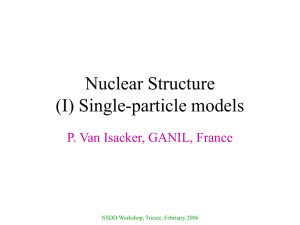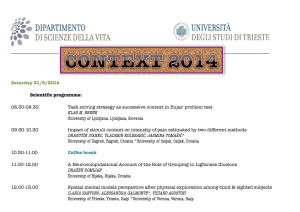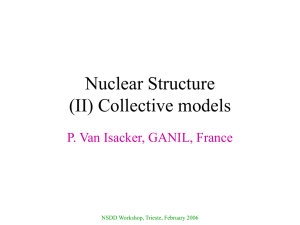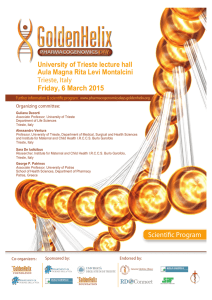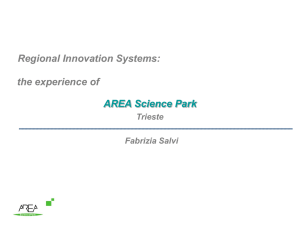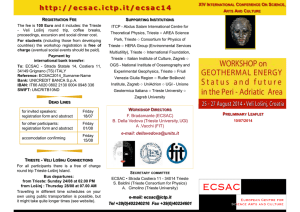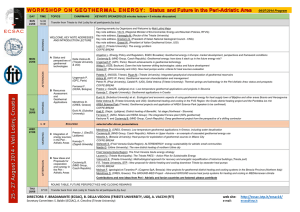Nuclear Structure Models - IAEA Nuclear Data Services
advertisement
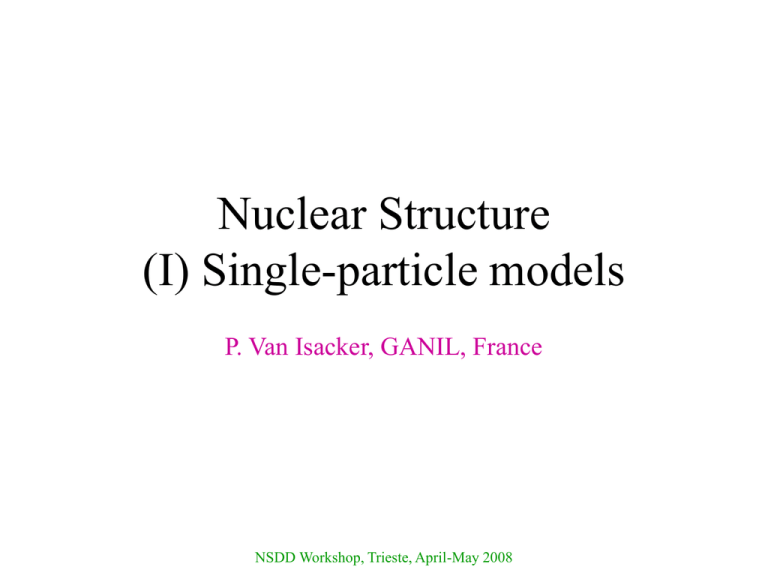
Nuclear Structure (I) Single-particle models P. Van Isacker, GANIL, France NSDD Workshop, Trieste, April-May 2008 Overview of nuclear models • Ab initio methods: Description of nuclei starting from the bare nn & nnn interactions. • Nuclear shell model: Nuclear average potential + (residual) interaction between nucleons. • Mean-field methods: Nuclear average potential with global parametrisation (+ correlations). • Phenomenological models: Specific nuclei or properties with local parametrisation. NSDD Workshop, Trieste, April-May 2008 Nuclear shell model • Many-body quantum mechanical problem: A A 2 p Hˆ k Vˆ2 rk ,rl 2mk kl k1 A pk2 A Vˆ rk Vˆ2 rk ,rl V rk kl k1 2mk k1 A mean field residual interaction • Independent-particle assumption. Choose V and neglect residual interaction: pk2 ˆ ˆ ˆ H HIP V rk k1 2mk A NSDD Workshop, Trieste, April-May 2008 Independent-particle shell model • Solution for one particle: p2 Vˆ r i r E ii r 2m • Solution for many particles: i1 i2 iA r1,r2 , A ,rA ik rk k1 Hˆ IPi1 i2 A ,rA E ik i1 i2 iA r1,r2 , k1 iA NSDD Workshop, Trieste, April-May 2008 r1,r2, ,rA Independent-particle shell model • Anti-symmetric solution for many particles (Slater determinant): i1 i2 iA r1,r2 , ,rA i r1 i r2 1 i r1 i r2 A! 1 1 2 2 i r1 i r2 A A • Example for A=2 particles: 1 i1 i2 r1,r2 i1 r1 i2 r2 i1 r2 i2 r1 2 NSDD Workshop, Trieste, April-May 2008 i rA i rA 1 2 i rA A Hartree-Fock approximation • Vary i (ie V) to minize the expectation value of H in a Slater determinant: * i1i2 * i1 i2 r1,r2 , i r1,r2 , iA A ,rA Hˆ i1 i2 ,rA i1 i2 r1,r2, r1,r2 , iA iA ,rA dr1dr2 ,rA dr1dr2 drA drA 0 • Application requires choice of H. Many global parametrizations (Skyrme, Gogny,…) have been developed. NSDD Workshop, Trieste, April-May 2008 Poor man’s Hartree-Fock • Choose a simple, analytically solvable V that approximates the microscopic HF potential: pk2 m 2 2 2 ˆ HIP rk lk sk lk 2 k1 2m A • Contains – Harmonic oscillator potential with constant . – Spin-orbit term with strength . – Orbit-orbit term with strength . • Adjust , and to best reproduce HF. NSDD Workshop, Trieste, April-May 2008 Harmonic oscillator solution • Energy eigenvalues of the harmonic oscillator: 1 1 l j l 2 E nlj N 32 2 ll 1 2 1 2 1 l 1 j l 2 2 N 2n l 0,1,2, : oscillatorquantumnumber n 0,1,2, : radialquantumnumber l N,N 2, ,1 or 0 : orbit alangular momentum j l 12 : totalangular momentum m j j, j 1, , j : z projectionof j NSDD Workshop, Trieste, April-May 2008 Energy levels of harmonic oscillator • Typical parameter values: 41 A1/ 3 MeV 2 20 A2 / 3 MeV 2 0.1 MeV b 1.0 A1/ 6 fm • ‘Magic’ numbers at 2, 8, 20, 28, 50, 82, 126, 184,… NSDD Workshop, Trieste, April-May 2008 Why an orbit-orbit term? • Nuclear mean field is close to Woods-Saxon: VˆWS r V0 r R0 1 exp a • 2n+l=N degeneracy is lifted El < El-2 < NSDD Workshop, Trieste, April-May 2008 Why a spin-orbit term? • Relativistic origin (ie Dirac equation). • From general invariance principles: 2 r 0 V ˆ VSO rl s, r in HO r r • Spin-orbit term is surface peaked diminishes for diffuse potentials. NSDD Workshop, Trieste, April-May 2008 Evidence for shell structure • Evidence for nuclear shell structure from – – – – 2+ in even-even nuclei [Ex, B(E2)]. Nucleon-separation energies & nuclear masses. Nuclear level densities. Reaction cross sections. • Is nuclear shell structure modified away from the line of stability? NSDD Workshop, Trieste, April-May 2008 Ionisation potential in atoms NSDD Workshop, Trieste, April-May 2008 Neutron separation energies NSDD Workshop, Trieste, April-May 2008 Proton separation energies NSDD Workshop, Trieste, April-May 2008 Liquid-drop mass formula • Binding energy of an atomic nucleus: 2 Z Z 1 N Z 2/3 BN,Z av A as A ac as 1/ 3 N,Z ap A1/ 3 A A • For 2149 nuclei (N,Z ≥ 8) in AME03: av16, as18, ac0.71, a's23, ap6 rms2.93 MeV. C.F. von Weizsäcker, Z. Phys. 96 (1935) 431 H.A. Bethe & R.F. Bacher, Rev. Mod. Phys. 8 (1936) 82 NSDD Workshop, Trieste, April-May 2008 The nuclear mass surface NSDD Workshop, Trieste, April-May 2008 The ‘unfolding’ of the mass surface NSDD Workshop, Trieste, April-May 2008 Modified liquid-drop formula • Add surface, Wigner and ‘shell’ corrections: Z Z 1 N,Z 2/3 BN,Z av A as A ac ap 1/ 3 1/ 3 Sv 1 y s A1/ 3 A A 4T T 1 2 af n n aff n n A • For 2149 nuclei (N,Z ≥ 8) in AME03: av16, as18, ac0.71, Sv35, ys2.9, ap5.5, af0.85, aff0.016 rms1.16 MeV. NSDD Workshop, Trieste, April-May 2008 Shell-corrected LDM NSDD Workshop, Trieste, April-May 2008 Shell structure from Ex(21) NSDD Workshop, Trieste, April-May 2008 Evidence for IP shell model • Ground-state spins and parities of nuclei: j in nl jm J J l in nl jm l j j NSDD Workshop, Trieste, April-May 2008 Validity of SM wave functions • Example: Elastic electron scattering on 206Pb and 205Tl, differing by a 3s proton. • Measured ratio agrees with shell-model prediction for 3s orbit. QuickTime™ et un décompresseur TIFF(non compressé) sont requis pour visionner cette image. J.M. Cavedon et al., Phys. Rev. Lett. 49 (1982) 978 NSDD Workshop, Trieste, April-May 2008 Variable shell structure NSDD Workshop, Trieste, April-May 2008 Beyond Hartree-Fock • Hartree-Fock-Bogoliubov (HFB): Includes pairing correlations in mean-field treatment. • Tamm-Dancoff approximation (TDA): – Ground state: closed-shell HF configuration – Excited states: mixed 1p-1h configurations • Random-phase approximation (RPA): Correlations in the ground state by treating it on the same footing as 1p-1h excitations. NSDD Workshop, Trieste, April-May 2008 Nuclear shell model • The full shell-model hamiltonian: pk2 A Hˆ Vˆ rk VˆRI rk ,rl kl k1 2m A • Valence nucleons: Neutrons or protons that are in excess of the last, completely filled shell. • Usual approximation: Consider the residual interaction VRI among valence nucleons only. • Sometimes: Include selected core excitations (‘intruder’ states). NSDD Workshop, Trieste, April-May 2008 Residual shell-model interaction • Four approaches: – Effective: Derive from free nn interaction taking account of the nuclear medium. – Empirical: Adjust matrix elements of residual interaction to data. Examples: p, sd and pf shells. – Effective-empirical: Effective interaction with some adjusted (monopole) matrix elements. – Schematic: Assume a simple spatial form and calculate its matrix elements in a harmonicoscillator basis. Example: interaction. NSDD Workshop, Trieste, April-May 2008 Schematic short-range interaction • Delta interaction in harmonic-oscillator basis: • Example of 42Sc21 (1 neutron + 1 proton): NSDD Workshop, Trieste, April-May 2008 Large-scale shell model • Large Hilbert spaces: i'1 i' 2 n i' A Vˆ r ,r RI k l i1 i2 iA kl – Diagonalisation : ~109. – Monte Carlo : ~1015. • Example : 8n + 8p in pfg9/2 (56Ni). M. Honma et al., Phys. Rev. C 69 (2004) 034335 NSDD Workshop, Trieste, April-May 2008 The three faces of the shell model NSDD Workshop, Trieste, April-May 2008 Racah’s SU(2) pairing model • Assume pairing interaction in a single-j shell: 1 2 j 1g0, J 0 2 2 2 ˆ j JMJ Vpairingr1,r2 j JMJ 0, J 0 • Spectrum 210Pb: NSDD Workshop, Trieste, April-May 2008 Solution of the pairing hamiltonian • Analytic solution of pairing hamiltonian for identical nucleons in a single-j shell: j nJ n 1 n ˆ V r ,r j J g pairing k l 0 4 n 2 j n 3 1kl • Seniority (number of nucleons not in pairs coupled to J=0) is a good quantum number. • Correlated ground-state solution (cf. BCS). G. Racah, Phys. Rev. 63 (1943) 367 NSDD Workshop, Trieste, April-May 2008 Nuclear superfluidity • Ground states of pairing hamiltonian have the following correlated character: – Even-even nucleus (=0): Sˆ o , Sˆ aˆ aˆ n /2 – Odd-mass nucleus (=1): m aˆ Ý Ý Ý m m Sˆ • Nuclear superfluidity leads to n /2 m o + – Constant energy of first 2 in even-even nuclei. – Odd-even staggering in masses. – Smooth variation of two-nucleon separation energies with nucleon number. – Two-particle (2n or 2p) transfer enhancement. NSDD Workshop, Trieste, April-May 2008 Two-nucleon separation energies • Two-nucleon separation energies S2n: (a) Shell splitting dominates over interaction. (b) Interaction dominates over shell splitting. (c) S2n in tin isotopes. NSDD Workshop, Trieste, April-May 2008 Pairing gap in semi-magic nuclei • Even-even nuclei: – Ground state: =0. – First-excited state: =2. – Pairing produces constant energy gap: Ex 21 12 2 j 1G • Example of Sn isotopes: NSDD Workshop, Trieste, April-May 2008 Elliott’s SU(3) model of rotation • Harmonic oscillator mean field (no spin-orbit) with residual interaction of quadrupole type: pk2 1 2 2 ˆ H m rk g2Qˆ Qˆ , 2 k1 2m A A Qˆ rk2Y2 rˆk k1 A pk2Y2 pˆ k k1 J.P. Elliott, Proc. Roy. Soc. A 245 (1958) 128; 562 NSDD Workshop, Trieste, April-May 2008
![locandina dottorandi [modalità compatibilità]](http://s2.studylib.net/store/data/005259821_1-9e349e4e3bf89f1cc48d1fe5ca196528-300x300.png)
